Product management meeting templates
You have probably been in a boring or unproductive meeting before. It can feel like your time is being sucked down a black hole — and would be better spent on something else. But with a little planning, you can avoid this gravitational pull and transform your meetings into meaningful uses of everyone's time.
For product managers, this is particularly essential. Meetings are opportunities to keep communication flowing throughout the entire product development process. It is your responsibility to align the cross-functional product team around priorities and move everyone forward. In fact, creating real product value often hinges on your ability to collaborate and deliver work efficiently as a team.
If your meetings are feeling lackluster, this guide will help. Find tips, examples, and free downloadable templates to start running more productive product management meetings — from daily product team standups to product launch kickoffs.
Drive better product team alignment — try Aha! software for free.
Types of product management meetings with templates
Meetings take up a significant portion of a product manager's day-to-day work. You might start your day at the product team standup, then lead a product launch kickoff in the afternoon. Most weeks you will also spend time preparing for roadmap presentations and other important meetings with company leadership and stakeholders.
Typically each type of meeting you attend should serve a distinct purpose. The list below provides an overview of six common types of product management meetings — accompanied by Aha! software templates and downloadable product management meeting templates. The templates will guide you through structuring your agenda, leading the discussion, and recording action items so you can lead each meeting with confidence.
Note that the focus here is on internal product management meetings versus customer-facing research sessions or product demos. This list is also methodology-agnostic. While these templates will work for any product team, you might hold additional meetings (and prefer to use different templates) if you practice scrum, for example, and conduct sprint reviews and retrospectives.
Jump to the template:
1. Daily product management standup template
What it is: A brief meeting for the core product management team to check in on tactical updates.
Who should attend: Product management, UX, engineering
Who should lead: Product manager
Frequency: Daily
Duration: 15–30 minutes
Discuss:
What you worked on yesterday
What you are working on today
Any blockers in your way
Try this daily standup template in Aha! software. Start a free trial.

2. Weekly product team meeting template
What it is: The broader product development team comes together to review progress on goals, work in progress, and any problems or opportunities that have arisen.
Who should attend: Cross-functional product development team (e.g., product management, project management, product marketing, engineering, sales, operations, innovation)
Who should lead: Product manager
Frequency: Weekly, sometimes biweekly
Duration: 1 hour
Discuss:
Progress against goals and initiatives
Product roadmap review
Recently completed work
Planned and upcoming work
New or notable customer feedback
Customer opportunities
Potential roadblocks and delays
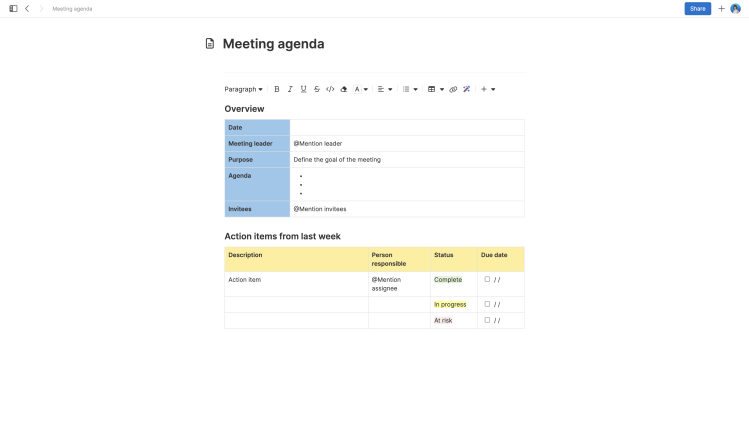
3. Product feature kickoff meeting template
What it is: Product kickoffs are held when your team starts work on a new product feature or release. These sessions are both informational and action-oriented, with time spent going over what is being built, how the feature will work, and next steps.
Who should attend: Varies depending on scope of the launch
Who should lead: Product manager
Frequency: Weekly, biweekly, or monthly (depending on your release cadence)
Duration: 1 hour
Discuss:
Overview of new functionality to be built — including how it works, timing, and business value
Target audience
User experience walkthroughs
Feedback, critiques, and questions
Go-to-market positioning
Review of product launch checklist
Next steps and action items
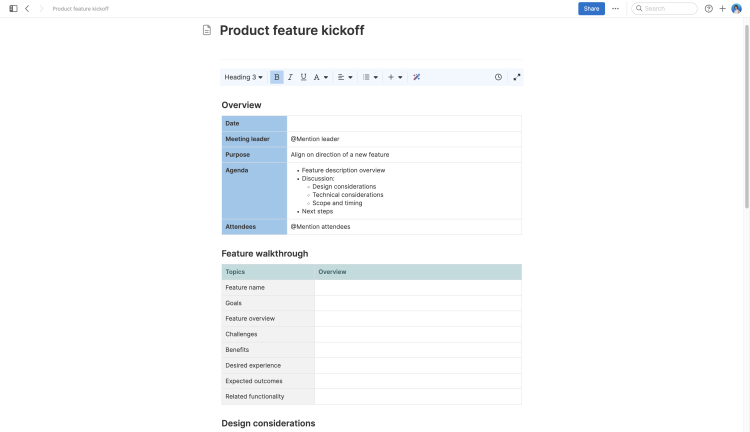
4. Product backlog refinement meeting template
What it is: Time to evaluate, organize, and prioritize product backlog items in a way that the entire team supports and understands. Backlog refinement meetings usually involve product management and development teams, but leadership and customer-facing team members may also attend.
Who should attend: Product management, UX, engineering, leadership, sales, customer support
Who should lead: Product manager or product owner
Frequency: Backlog refinement is ongoing — meetings can be weekly, monthly, or as needed
Duration: 1 hour
Discuss:
Current ideas and features in the product backlog
Whether backlog items still align with strategy
Top items in the product backlog
Adjustments to scoring, estimates, or details of backlog items
Upcoming work and deadlines
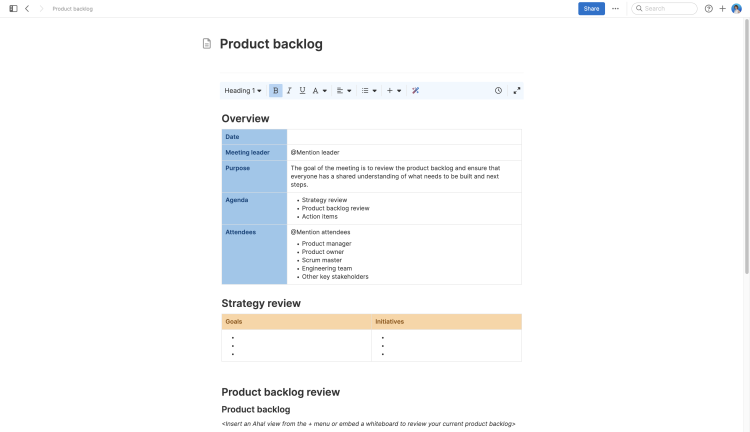
5. Product strategy meeting template
What it is: A deeper dive into business and product strategy — including progress and performance. These meetings often also include discussions around business needs and planning new goals and initiatives to address them.
Who should attend: Product management, leadership, other relevant stakeholders
Who should lead: Product manager
Frequency: Quarterly, biannual
Duration: 2+ hours, may require multiple sessions
Discuss:
Overview of vision, positioning, and market landscape
Progress on current goals and initiatives
Review of performance metrics, financial data, and roadmaps
Business needs and challenges
Future areas of investment
Setting new goals or refining existing ones
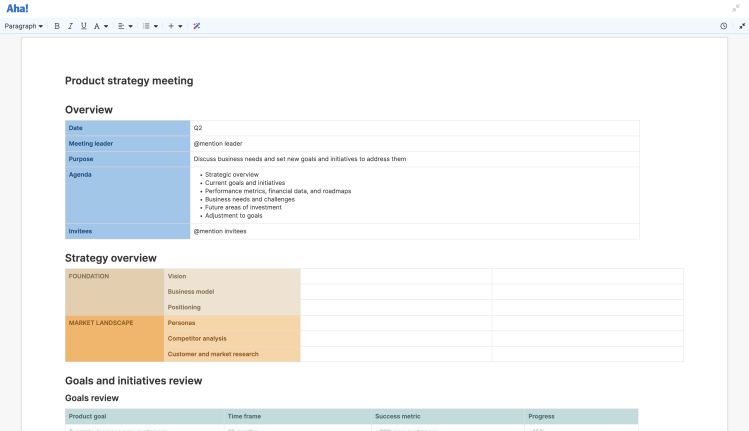
6. Product operations meeting template
What it is: Enterprise companies with large product portfolios and multiple product teams hold product operations meetings. Instead of discussing the product itself, much of the discussion centers on internal processes, tools, and cross-team alignment.
Who should attend: Product operations, product management
Optional attendees: Engineering, sales, customer success, leadership
Who should lead: Product operations manager
Frequency: Biweekly, monthly
Duration: 1 hour
Discuss:
Alignment on high-level priorities across product teams
Current product management processes — including wins and setbacks
Opportunities to improve workflows, communication, etc.
Review of current technology and needs for new tools
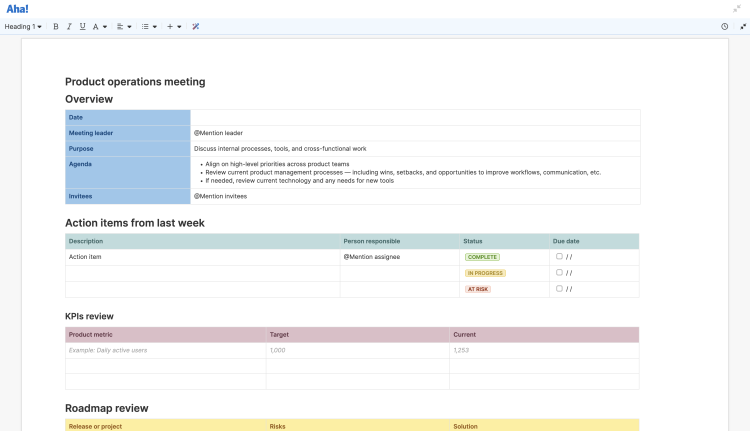
Tips for better product management meetings
Now that you are equipped with product meeting templates, let's review some best practices. Try these tips if your product management meetings need a revamp.
Create a clear agenda: Include discussion items, designated speakers, and if needed, the estimated duration for each meeting segment. Note any prep work necessary for attendees and send the agenda out in advance.
Do not dictate — discuss: Product managers facilitate most product team meetings. Remember that these meetings are not scripted presentations, but rather opportunities to learn from and empathize with your team. Set the stage, then open up the conversation to other attendees and listen.
Bring evidence: In certain types of product team meetings, you will go deep into discussing goals and priorities. Share stories from customers and back up talking points with data when relevant. This helps to center your conversations on solving the real problems your team and customers face.
Encourage creativity: A set agenda should not squash open discussion — you want to embrace new feedback and ideas. Be curious about what each team is hearing or experiencing throughout the product development process.
Stay relevant: While open discussion is encouraged, be wary of getting sidetracked. Redirect the conversation if it gets off-topic or too granular.
Welcome debate: When disagreements inevitably arise, allow room for varying viewpoints. Flesh out different perspectives before immediately trying to resolve the conflict (barring any antagonistic exchanges).
Mind the time: Some product management meetings only need about 15 minutes — while others will require upwards of two hours. Either way, stick to the duration outlined in your agenda. This will help you keep pace and show others that you value their time. You can always regroup later or pick things back up in the next meeting.
End with action: Define owners, supporters, and approvers for action items at the end of every meeting based on what was discussed.
Together these best practices will help improve your product management meetings from beginning to end. If your meetings need a lot of improvement, try an iterative approach by starting with one or two tips and working through the rest over time.
Related: More surprising tips for better product team meetings
With these tips and templates on hand, expect to see an efficiency boost in your next product management meetings. Customize them as you learn what works for your team. And as you continue to optimize your time together, you will see the results in a better product, happier customers, and a stronger sense of shared purpose.